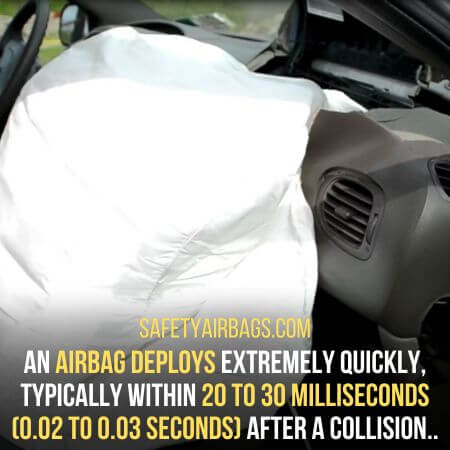How fast does an airbag deploy? The deployment speed can vary depending on the specific vehicle and the type of airbag system it has.
What Will I learn
- 1 How Fast Does An Airbag Deploy? Generally
- 2 Factors Influencing the Speed of Airbag Deployment
- 3 Deployment Speed in Side Collisions
- 4 Factors Affecting Deployment Speed in Side Collisions
- 5 Deployment Speed in Rollover Accidents
- 6 Factors Affecting Deployment Speed in Rollover Accidents
- 7 Considerations for Airbag Deployment in Autonomous Vehicles
- 8 Public Perception and Education on Airbag Deployment
- 9 Ethical Considerations in Airbag Deployment
- 10 Conclusion:
Understanding how quickly airbags deploy in different collision scenarios can provide valuable insights into their effectiveness and potential impact on occupant safety.
How Fast Does An Airbag Deploy? Generally
An airbag deploys extremely quickly, typically within 20 to 30 milliseconds (0.02 to 0.03 seconds) after a collision is detected.
The airbag deployment process is a crucial component of vehicle safety systems.
When a collision occurs, the process is initiated by various sensors strategically placed throughout the vehicle.

These sensors detect the impact and send signals to the airbag control module, which is the central processing unit.
The module analyzes the sensor data and determines whether airbag deployment is necessary.
If deployment is deemed necessary, the module triggers the ignition of the airbag inflator, rapidly releasing gas to inflate the airbag.
The inflated airbag is a cushioning barrier between the occupants and the vehicle’s interior, reducing the risk of severe injuries.
Factors Influencing the Speed of Airbag Deployment
Several factors can influence the speed of airbag deployment in a collision. These factors include:
1. Collision Severity:
The severity of the impact plays a significant role in determining the airbag deployment speed.
Higher impact forces require faster deployment to provide effective occupant protection.
2. Sensor Sensitivity and Response Time:
The sensitivity and response time of the crash sensors affects how quickly they can detect the collision and send signals to the airbag control module.
Advanced sensors with higher sensitivity and faster response times enable quicker deployment.
3. Airbag Inflator Design:
The design of the airbag inflator, including the type of fuel used, can impact the deployment speed.
Different fuels have varying burn rates, which affect how rapidly the gas is generated to inflate the airbag.
4. System Design and Integration:
The overall design and integration of the airbag system within the vehicle can influence deployment speed.
Factors such as the routing of electrical connections, placement of sensors, and the efficiency of the control module can all impact the speed of deployment.
Deployment Speed in Side Collisions
Side collisions, or T-bone or broadside collisions, occur when the front or rear of one vehicle strikes the side of another vehicle.
These collisions can be particularly dangerous as the side of a vehicle offers less protection compared to the front or rear.
The typical deployment speed of airbags in side collisions can vary depending on several factors.
However, generally speaking, airbags in side collisions tend to deploy more rapidly compared to frontal collisions.
Faster deployment is necessary to provide occupant protection in situations with limited space between the occupant and the point of impact.
Factors Affecting Deployment Speed in Side Collisions
Several factors can influence the deployment speed of airbags in side collisions. These factors include:
1. Impact Location:
The location of the impact on the vehicle can impact the deployment speed.
Side impacts closer to the occupants, such as near the door where they are seated, may require faster deployment to provide effective protection.
2. Sensor Placement and Sensitivity:
The placement and sensitivity of the crash sensors in the vehicle play a crucial role in detecting side collisions accurately.

Sensors strategically positioned in the vehicle’s side structure can detect the impact and trigger rapid deployment.
3. Occupant Detection Systems:
Some vehicles are equipped with occupant detection systems that can sense the presence of occupants in the affected area during a side collision.
These systems can provide additional information to the airbag control module, enabling customized deployment and faster response times.
Curtain Airbag Design:
Curtain airbags, specifically designed for side impact protection, typically deploy from the vehicle’s roofline.
These airbags’ design and deployment mechanisms are optimized for rapid inflation and coverage along the side window area.
System Integration and Efficiency:
The integration and efficiency of the airbag system components, including the control module and the inflators, play a role in determining the deployment speed.
Efficient communication and coordination between these components can contribute to faster deployment.
Manufacturers continually evaluate and improve the design and deployment strategies to enhance the effectiveness and speed of airbag deployment in side collisions.
By considering these factors, engineers aim to provide optimal protection to vehicle occupants during a side collision.
Deployment Speed in Rollover Accidents
Rollover accidents involve a vehicle rolling onto its side or roof due to a sharp turn, loss of control, or collision with another vehicle or obstacle.
These accidents are typically associated with high–energy forces and can result in severe injuries to the occupants.
Typical Deployment Speed in Rollover Accidents:
The deployment speed of airbags in rollover accidents can vary depending on the specific circumstances of the accident.
Rollover accidents often involve multiple impacts, including initial contact and subsequent impacts with the ground or other objects.
These factors may influence the deployment speed.
Factors Affecting Deployment Speed in Rollover Accidents
Several factors can influence the deployment speed of airbags in rollover accidents:
1. Rollover Detection Systems:
Advanced rollover detection systems utilize a combination of sensors, including accelerometers and gyroscopes, to detect the initiation of a rollover.
These systems play a crucial role in triggering rapid airbag deployment.
2. System Integration and Response Time:
Integrating the rollover detection system with the overall vehicle safety system is essential for quick deployment.
The seamless communication and rapid response between the sensors, control module, and airbag inflators are critical in achieving fast deployment speeds.
3. Curtain Airbag Design:
In rollover accidents, curtain airbags protect occupants’ heads from impacts on the vehicle’s roof and side structures.
Curtain airbags’ design and deployment characteristics are specifically optimized to mitigate head injuries in rollover scenarios.
4. Safety Regulations and Standards:
Safety regulations and standards specify airbag deployment speed requirements in rollover accidents.
Manufacturers must comply with these regulations to ensure effective occupant protection during rollovers.
Considerations for Airbag Deployment in Autonomous Vehicles
Unique challenges and considerations for airbag deployment in autonomous vehicles include the need for advanced sensor technology to detect collisions accurately:
1. Sensor Systems:
Autonomous vehicles are equipped with advanced sensor systems, such as lidar, radar, and cameras, to perceive the surrounding environment.
These sensors provide valuable data for decision-making during autonomous driving.
But they may require coordination with airbag deployment to ensure accurate detection and timely response to potential collisions.
2. Communication Networks:
Autonomous vehicles rely on sophisticated communication networks to exchange information between components and infrastructure.

Effective integration of airbag deployment with these networks is crucial to ensure rapid and precise response in the event of a collision.
Integration of advanced sensor systems and communication networks:
Integrating advanced sensor systems and communication networks is vital in optimizing airbag deployment in autonomous vehicles.
Seamless communication and data sharing between the sensors, control systems, and airbag modules enable real-time detection of potential collisions.
This then prompt deployment of the airbags in an effective manner.
Coordination with other safety features in autonomous driving technology:
Airbag deployment in autonomous vehicles needs to be coordinated with other safety features.
These include automatic emergency braking, collision avoidance systems, and seatbelt pre-tensioners.
Harmonizing the operation of these safety features ensures comprehensive occupant protection during potential collision scenarios.
Public Perception and Education on Airbag Deployment
Public awareness campaigns educate drivers and passengers about airbag deployment and its importance in vehicle safety.
These campaigns can focus on explaining the purpose of airbags, their deployment process, and the need to follow recommended safety guidelines.
Addressing concerns and misconceptions surrounding airbag deployment:
The public often has misconceptions and concerns regarding airbag deployments, such as the fear of unnecessary deployment or potential injuries.
It is important to address these concerns through clear and accurate information, emphasizing the effectiveness and extensive testing that goes into airbag systems.
Promoting responsible behavior and proper understanding of airbag safety:
Promoting responsible behavior and a proper understanding of airbag safety is essential.
This includes encouraging proper seating positions, and avoiding tampering with airbag systems.

This also involves following safety guidelines provided by vehicle manufacturers and regulatory authorities.
Ethical Considerations in Airbag Deployment
Balancing the protection of vehicle occupants from the potential harm airbags may cause pedestrians or cyclists in the event of a collision is important.
Designing airbag systems prioritizing occupant safety while minimizing harm to others is a complex challenge.
Ethical dilemmas in situations where a deployment may not be ideal:
There may be scenarios where airbag deployment may not be ideal, such as in certain low-speed collisions or when occupants are not properly restrained.
Ethical considerations arise in determining the circumstances in which airbags should be deployed to maximize overall safety and minimize the risk of unintended harm.
Industry discussions and regulations regarding ethical considerations:
The automotive industry and regulatory bodies engage in ongoing discussions to address the ethical considerations of airbag deployment.
These discussions aim to establish guidelines and regulations that align with ethical principles and ensure the responsible use of airbag systems.
Conclusion:
In conclusion, airbags deploy incredibly quickly, typically within 20 to 30 milliseconds (0.02 to 0.03 seconds) after a collision is detected.
This rapid deployment is essential for their effectiveness in protecting vehicle occupants.
